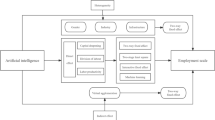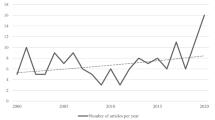Abstract
In this paper, we analyse the effect of promoting workers’ employability on labour productivity. To this end, we adapt a simple efficiency-wage model that includes the employer’s decision on the provision of opportunities for enhancing workers’ employment prospects in a context of job insecurity. We show that (i) by facilitating workers’ employability, the firm increases its labour productivity; and (ii) the higher the job uncertainty the higher the productivity gains due to the increase in employability. One of the advantages of our model is that it is simply enough to allow us to formulate two testable hypotheses, namely (i) the increase of jobs’ potential to enhance workers’ employability results in higher level of workers’ effort, and (ii) the provision of employability is more profitable for small and medium enterprises (SMEs) than for large firms. More precisely, SMEs should obtain higher effort levels from employees by fostering workers’ employability than large firms. We provide some evidence supporting these hypotheses from a highly representative sample of Spanish manufacturing firms.
Similar content being viewed by others
References
Aaronson, D. and D. G. Sullivan, 1998, The decline of job security in the 1990s: Displacement, anxiety, and their effect on wage growth, Federal Reserve Bank of Chicago. Economic Perspectives (1st Quarter), 17–43
Arocena P. and Villanueva M. (2003). Access as a motivational device: Implications for human resource management. Kyklos 56(2): 199–220
Arranz, J. M. and C. García-Serrano, 2004, La seguridad del empleo en España: evidencia con datos de la EPA (1987–2003), Papeles de Trabajo 5/04. Instituto de Estudios Fiscales, Ministerio de Hacienda
Baron J. and Kreps D. (1999). Human Resource Management: A Framework for General Managers. John Wiley & Sons, New York
Brown C. and Medoff J. L. (1989). The employer size-wage effect. Journal of Political Economy 97(5): 1027–1059
Burchell B., Ladipo D. and Wilkinson F. (2002). Job Insecurity and Work Intensification. Routledge, London
Cotton K. (1993). Developing Employability Skills. School Improvement Research Series. Regional Educational Laboratory, Portland
Sanders J. (2004). The industry employability index: Taking account of supply and demand characteristics. International Labor Review 143(3): 211–233
Dunne T., Roberts M. J. and Samuelson L. (1989). The growth and failure of U.S. manufacturing plants. Quarterly Journal of Economics 104(4): 671–698
Ellig B. R. (1998). Employment and employability: Foundation of the new social contract. Human Resource Management 37(2): 173–175
Evans D. S. and Leighton L. S. (1988). Why do smaller firms pay less?. Journal of Human Resources 24(2): 299–318
Even W. E. and MacPherson D. A. (1996). Employer size and labor turnover: The role of pensions. Industrial and Labor Relations Review 49(4): 707–728
Flabbi L. and Ichino A. (2001). Produtivity, seniority and wages: new evidence from personnel data. Labor Economics 8(3): 359–388
Frey B. (1997). Not Just for the Money. Edward Elgar Publishing, Brookfield
Goshal, S., P. Moran and C. A. Bartlett, 1997, Employment Security, Employability and Sustainable Competitive Advantage, Working Paper 97/20/SM. INSEAD Working Paper Series
Green F., Felstead A. and Burchell B. (2000). Job insecurity and the difficulty of regaining employment: An empirical study of unemployment expectations. Oxford Bulletin of Economics and Statistics 62(December): 857–885
Greene W. H. (2002). Econometric Analysis. Prentice-Hall.
Greenhalgh L. and Sutton R. (1991). Organizational Effectiveness and Job Insecurity. In: Hartley, J., Jacobson, D. and Klandermans, B. (eds) Job Insecurity: Coping with Jobs at Risk, pp. Sage, London
Groot W. and Maassen Brink H. (2000). Education, training and employability. Applied Economics 32: 573–581
Hawkins P. 1999, The Art of Building Windmills, Graduate into Employment Unit, University of Liverpool
Huerta E., Bayo J. A., García M. C. and Merino J. (2003). Los desafíos de la competitividad: la innovación organizativa y tecnológica en la empresa española. Fundación BBVA, Bilbao
Ichniowski C., Kochan T. A., Levine D. and Olson C. (1996). What works at work: Overview and assessment. Industrial Relations 35(3): 299–333
Idson L. (1996). Employer size and labor turnover. Research in Labor Economics 15: 273–304
ILO, 2000, Training for Employment: Social Inclusion, Productivity and Youth Employment, International Labor Conference, 88th Session, Report V, Geneva
ILO, 2005, http://www.ilo.org/iloterm
Johansson P. and Palme M. (1996). Do economic incentives affect work absence? Empirical evidence using Swedish micro data. Journal of Public Economics 59: 195–218
Johansson P. and Palme M. (2002). Assessing the effect of public policy on worker abserteeism. Journal of Human Resources 37(2): 381–409
Kalleberg A. L. and Mastekaasa A. (1998). Organizational size, layoffs and quits in Norway. Social Forces 76(4): 1243–1273
Kochan A. Thomas (1994). The Mutual Gains Enterprise. Harvard Business School Press, Boston
Lazear E. P. (1995). Personnel Economics. The MIT Press, Cambridge (MA)
Näswall K. (2003). Objective’ vs ‘subjective’ job insecurity: consequences of temporary work for job satisfaction and organizational commitment in four European countries. Economic and Industrial Democracy 24(2): 149–188
Nickell S., Jones P. and Quintini G. (2002). A picture of job insecurity facing British men. Economic Journal 112 (January): 1–27
OECD, 1997, ‘Is Job Insecurity on the Increase in OECD Countries?’ in Employment Outlook, Chapter 5, Paris: OECD
Osterman P (2000). Work reorganization in an era of restructuring: Trends in diffusion and effects on employee welfare. Industrial and Labor Relations Review 53(2): 179–196
Peters L. H., Greeer C. R. and Youngblood S. S. (1998). Blackwell Encyclopedic Dictionary of Human Resource Management. Blackwell, Oxford
Sanders J. and Grip A. (2004). Training, task flexibility and the employability of low-skilled workers. International Journal of Manpower 25(1): 73–89
Saphiro C. and Stiglitz J. E. (1984). Equilibrium unemployment as a worker discipline device. American Economic Review 74(3): 433–444
Schdmidt S. (1999). Long-run trends in workers beliefs about their own job security: Evidence from the General Social Survey. Journal of Labor Economics 17(4): 127–141
Stoikov V. and Raimon R. L. (1968). Determinants of differences in the quit rates among industries. American Economic Review 58: 1283–1298
Klandermans B., Jacobson D., Hartley J. and Vuuren T. (1991). Employee’s Reactions to Job Insecurity. In: Hartley, J., Jacobson, D., and Klandermans, B. (eds) Job Insecurity: Coping with Jobs at Risk, pp. Sage, London
Wagner J. (1997). Firm size and job quality: A survey of the evidence from Germany. Small Business Economics 9(5): 411–425
Waterman, R. H., J. A. Waterman and B. Collard, 1994, Toward a Career-Resilient Workforce, Harvard Business Review (July–August), 87–95
Winter-Ebmer R (2001). Firm size, earnings and displacement risk. Economic Inquiry 39(3): 474–486
Author information
Authors and Affiliations
Corresponding author
Additional information
This research has been funded by the Spanish Ministry of Education and Science, project SEJ2004-07242-C03-02.
Rights and permissions
About this article
Cite this article
Arocena, P., Núñez, I. & Villanueva, M. The Effect of Enhancing Workers’ Employability on Small and Medium Enterprises: Evidence from Spain. Small Bus Econ 29, 191–201 (2007). https://doi.org/10.1007/s11187-006-6712-7
Accepted:
Published:
Issue Date:
DOI: https://doi.org/10.1007/s11187-006-6712-7




